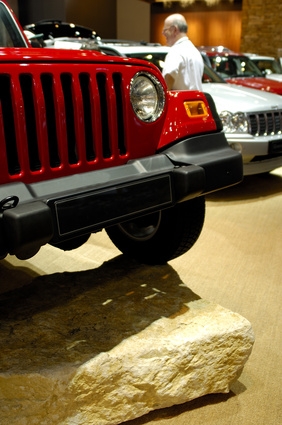
Jeep has produced the Cherokee SUV since 1974, with major redesigns occurring in 1984, 1997, and 2002. In 2008 the Cherokee was re-branded as a Jeep Liberty. Early models were carbureted and in 1986 Jeep switched to fuel injection in all its Cherokee engines. The original model had four different engine choices, from an inline 6 cylinder to a massive 401 c.i. V8. The second generation had seven possible engine choices including two diesels. The third generation had only five engine choices as did generations four and five, albeit with different engines each time.
Check the battery connections first. Disconnect the battery cables with a wrench and clean the posts and connectors with a wire brush. Always use a socket or box wrench as an open ended wrench will wear the corners off the bolt on the cable connectors and it will become impossible to fully tighten them.
Switch on the wipers or headlights with the ignition key in the "On" position. If nothing works, the battery is likely discharged and requires charging or replacement.
Switch ignition key to the "On" position and adjust the transmission shifter to ensure it is in the "Park" or "Neutral" position. This only applies to automatic transmissions.
Lift the vehicle up with a jack and rest it on jack stands. Inspect the electrical connection between the battery and starter motor. Replace the main positive cable from the battery if it is damaged and clean and tighten the connection at the starter solenoid. The starter motor is located on the lower side of the bell housing just behind the engine.
Remove the starter motor and electrical connections with a wrench and inspect it to see if the pinion gear has become jammed in the flywheel. In some cases you may be able to unjam the pinion and get it working again but it likely should be replaced before it gets jammed again. Remove the starter and solenoid and have a mechanic test that it is functioning properly.
Check the fuel tank for fuel. If there is fuel then it may not be reaching the engine. Start by checking the fuel filter. There are over 25 different engines in the Cherokee, but most will either be at the carburetor in older engines, or inline in fuel injected engines. Disconnect the filter with wrenches and inspect for water or dirt. Most filters cannot be cleaned and reinstalled so be prepared to install a new filter. Fuel injected systems must be depressurized before removing the filter.
Test the fuel pump. In most cases this means disconnecting the fuel line at the carburetor or throttle body and cranking the engine while holding a fuel line into a container. The process is more complicated with fuel injected systems but the goal is the same, to see if fuel comes out when the engine turns over. If no fuel comes out then the fuel pump either needs replacing or its electrical connections are loose or corroded or there is damage to the wires.
Inspect the carburetor, if your engine has one. Remove the wing nut on the air filter and lift the air filter assembly from the top of the carburetor. Check if the choke is stuck, the carburetor jets clogged, or the float has stuck. Any of these problems may require analysis and repair by a trained mechanic.
Remove several spark plugs with a wrench and inspect for spacing and buildup of carbon or oil deposits. Inspect the spark plug cables for damage and that they are securely connected at the plug and distributor. Replace any faulty cables. On older models check that the distributor cap is tight and there is not water inside it. Remove the timing chain cover with a wrench and inspect the chain for damage or breakage.